Intel Core i9-10850K Review: The Real Intel Flagship
by Dr. Ian Cutress on January 4, 2021 9:00 AM EST- Posted in
- CPUs
- Intel
- Core
- Z490
- 10th Gen Core
- Comet Lake
- LGA1200
- i9-10850K
CPU Tests: Encoding
One of the interesting elements on modern processors is encoding performance. This covers two main areas: encryption/decryption for secure data transfer, and video transcoding from one video format to another.
In the encrypt/decrypt scenario, how data is transferred and by what mechanism is pertinent to on-the-fly encryption of sensitive data - a process by which more modern devices are leaning to for software security.
Video transcoding as a tool to adjust the quality, file size and resolution of a video file has boomed in recent years, such as providing the optimum video for devices before consumption, or for game streamers who are wanting to upload the output from their video camera in real-time. As we move into live 3D video, this task will only get more strenuous, and it turns out that the performance of certain algorithms is a function of the input/output of the content.
HandBrake 1.32: Link
Video transcoding (both encode and decode) is a hot topic in performance metrics as more and more content is being created. First consideration is the standard in which the video is encoded, which can be lossless or lossy, trade performance for file-size, trade quality for file-size, or all of the above can increase encoding rates to help accelerate decoding rates. Alongside Google's favorite codecs, VP9 and AV1, there are others that are prominent: H264, the older codec, is practically everywhere and is designed to be optimized for 1080p video, and HEVC (or H.265) that is aimed to provide the same quality as H264 but at a lower file-size (or better quality for the same size). HEVC is important as 4K is streamed over the air, meaning less bits need to be transferred for the same quality content. There are other codecs coming to market designed for specific use cases all the time.
Handbrake is a favored tool for transcoding, with the later versions using copious amounts of newer APIs to take advantage of co-processors, like GPUs. It is available on Windows via an interface or can be accessed through the command-line, with the latter making our testing easier, with a redirection operator for the console output.
We take the compiled version of this 16-minute YouTube video about Russian CPUs at 1080p30 h264 and convert into three different files: (1) 480p30 ‘Discord’, (2) 720p30 ‘YouTube’, and (3) 4K60 HEVC.
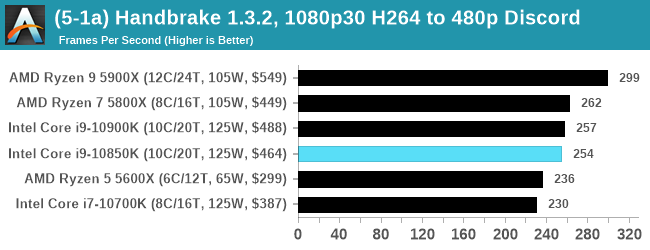
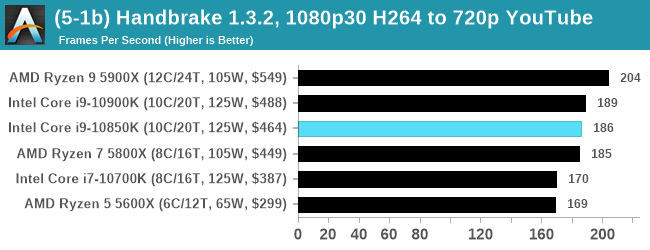
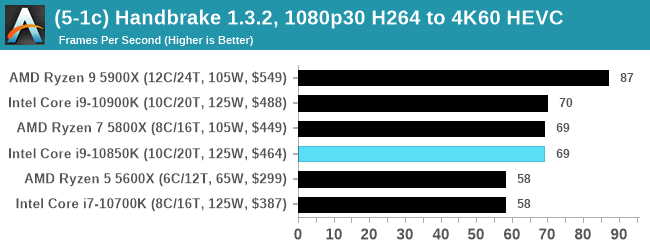
7-Zip 1900: Link
The first compression benchmark tool we use is the open-source 7-zip, which typically offers good scaling across multiple cores. 7-zip is the compression tool most cited by readers as one they would rather see benchmarks on, and the program includes a built-in benchmark tool for both compression and decompression.
The tool can either be run from inside the software or through the command line. We take the latter route as it is easier to automate, obtain results, and put through our process. The command line flags available offer an option for repeated runs, and the output provides the average automatically through the console. We direct this output into a text file and regex the required values for compression, decompression, and a combined score.
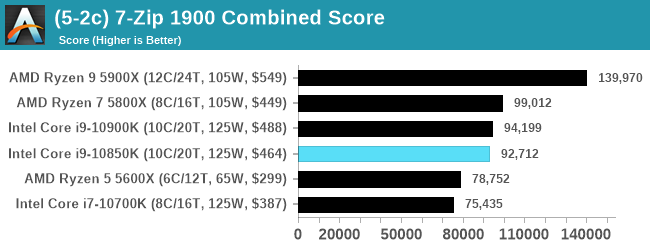
AES Encoding
Algorithms using AES coding have spread far and wide as a ubiquitous tool for encryption. Again, this is another CPU limited test, and modern CPUs have special AES pathways to accelerate their performance. We often see scaling in both frequency and cores with this benchmark. We use the latest version of TrueCrypt and run its benchmark mode over 1GB of in-DRAM data. Results shown are the GB/s average of encryption and decryption.
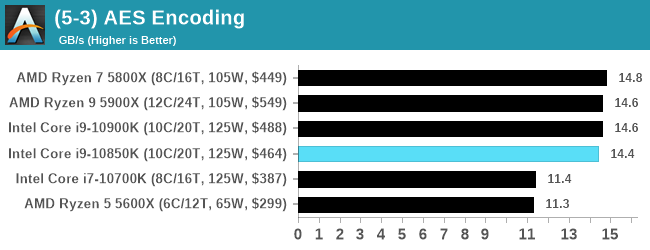
WinRAR 5.90: Link
For the 2020 test suite, we move to the latest version of WinRAR in our compression test. WinRAR in some quarters is more user friendly that 7-Zip, hence its inclusion. Rather than use a benchmark mode as we did with 7-Zip, here we take a set of files representative of a generic stack
- 33 video files , each 30 seconds, in 1.37 GB,
- 2834 smaller website files in 370 folders in 150 MB,
- 100 Beat Saber music tracks and input files, for 451 MB
This is a mixture of compressible and incompressible formats. The results shown are the time taken to encode the file. Due to DRAM caching, we run the test for 20 minutes times and take the average of the last five runs when the benchmark is in a steady state.
For automation, we use AHK’s internal timing tools from initiating the workload until the window closes signifying the end. This means the results are contained within AHK, with an average of the last 5 results being easy enough to calculate.
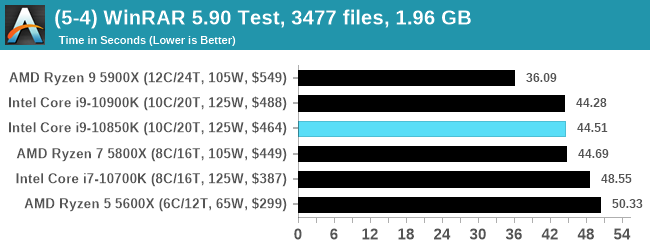


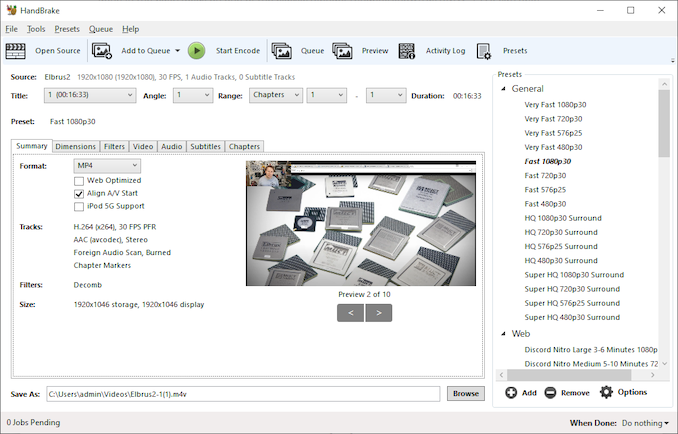
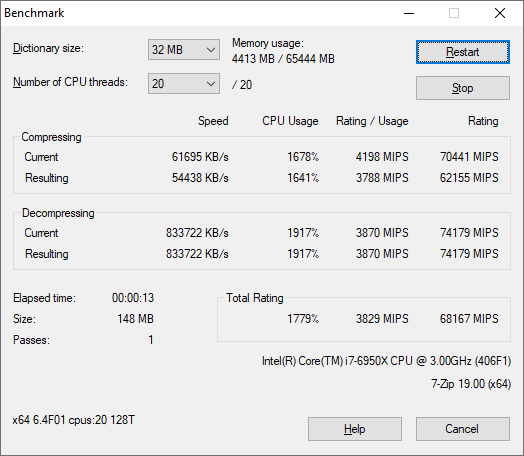









126 Comments
View All Comments
Deicidium369 - Monday, January 4, 2021 - link
And TSMC is really killing the fabrication front with the inability to ship anything in meaningful numbers - due to a extremely fragile supply chain - other than Apple - everything else in still on some variation of TSMC's 10nm class process - they call "7nm"sadick - Monday, January 4, 2021 - link
You are right, but Intel desktop CPUs are manufactured on the 14nm process since 2014!!! Ok, it's 14++++ now, but what an evolution, I'm very impressed ;-)I'm not an AMD fan boy, actually using a i7-9700k!
regsEx - Thursday, January 7, 2021 - link
At least they are much cheaper. 10-core 10850K cost same as 6-core 5600X.Impostors - Monday, January 4, 2021 - link
So is apple? Lmfao you thought they were making the chips? TSMC isn't behind on production, they are the production for literally everyone, from PC to mobile.name99 - Monday, January 4, 2021 - link
"you could argue that was the right call given the state of the market"Only if you drank your own koolaid about the end of Moore's Law...
Remember a book called _Only the Paranoid Survive_? About how in High Tech there are *constant* upsets and changes, nothing ever stays the same?
Hmm, if only someone at Intel had read that book and though "Gee, this seems to describe an industry very much like the one in which we operate"...
0ldman79 - Saturday, January 9, 2021 - link
Playing it safe would have been fine if they had a product to release afterwards.Thing is they didn't. They got so cocky they screwed up their fabs, reached too far while physics are only getting tougher to overcome.
TSMC made 7nm work, whether it hit their target density and speed goals or not it works. Intel had a goal and rather than back off as needed to release a product they kept fighting to hit an ego check-mark. When 10nm didn't work they should have backed off the density and tried again in order to release a product. Ultimately that's what they had to do but they did it 3 years too late.
WaltC - Monday, January 4, 2021 - link
M1 has very little in software and hardware compatibility to recommend it, however. Those are the #1 reasons people buy computer systems--raw performance is merely icing on the cake. AMD blows the M1, and Intel CPUs, away, imo. As it sits today, the M1 is not competitive with AMD (or even Intel, actually) in terms of multithreaded performance desktops & enterprise-level offerings. I very much doubt Apple will be going there--but we shall see...M1 as it sits is a good beginner's start...let's see where it goes from there.Great_Scott - Monday, January 4, 2021 - link
The techie rant from the early 2000's is coming to pass, finally.So many programs are either mobile or browser-based that the M1 is going to get a pass on compatibility.
Apple got lucky on the timing, in other words.
name99 - Monday, January 4, 2021 - link
Geniuses (and genius companies) make their own timing...Seems kinda bizarre to consider the rise of mobile computing as an exogenous factor when discussing Apple!
Calin - Tuesday, January 5, 2021 - link
Just read an article about Flash no longer being supported... and it was instead replaced by HTML5 and the like...Guess that genius companies really are lucky indeed ;)